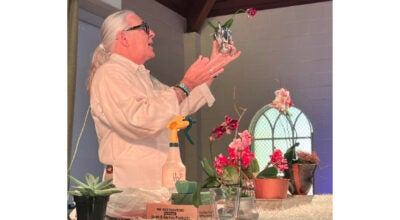Trinity garden looking for butterfly royalty
Published 12:00 am Friday, April 10, 2015

Trinity Episcopal School students tend to the garden behind the school Wednesday. Ninth-grade students at the school are planting flowers to attract butterflies as they migrate to South America. (Sam Gause / The Natchez Democrat)
NATCHEZ — A king deserves hospitable overnight accommodations, and that’s exactly what Trinity Episcopal Day School students intend to provide.

Trinity Episcopal School ninth-grade student Kaitlyn Lees plants flowers while classmate Anfernee Thomas rakes soil. The students are planting to attract butterflies migrating to South America. (Sam Gause / The Natchez Democrat)
The monarch butterfly — nicknamed the king of the butterfly species and known for its bright orange and black pattern — will have a safe and welcoming place for a pit stop, should they choose it, in Natchez this September as it migrates south for the winter.
And because monarch butterfly habitats are quickly declining, Trinity students have constructed a monarch waystation, which consists of a 50 square feet garden containing favorable plants, like milkweed, necessary for the butterfly to sustain migration.
The waystation is part of a larger initiative called Monarch Watch, a nonprofit program dedicated to the education and conservation of the monarch butterfly.
“They migrate from Canada down to South America in the late spring and early fall,” said Nan Huff, who teaches science at Trinity. “In Mississippi, we’re on the edge of the migration pattern, but we hope we can still help them on their journey.”
Huff, along with more than 20 physical science students, built the waystation April 3. Since then, students have been planting nectar sources throughout the garden and learning about the monarch’s upcoming migration.

Trinity Episcopal School eighth-grade students Colby Passman, left, and Everett Washington, right, water their vegetables in the school’s garden. (Sam Gause / The Natchez Democrat)
“Once we have everything in place, we’ll have a sign that says ‘Monarch Waystation’ and it will be registered with Monarch Watch,” Huff said.
According to Monarch Watch, 90 percent of monarch habitats occur within an agricultural landscape, thus farm practices have the potential to strongly influence the butterfly’s population. With the increasing development of subdivisions, factories and shopping centers, those habitats are declining.
Also, with the widespread adoption of herbicide-resistant planting, more than 80 million acres of monarch habitats have been lost in recent years, according to the Monarch Watch website.
“Through this program, we can help conserve and protect those habitats,” said Huff, adding that the program will also serve as an educational opportunity for next year’s biology students. “The monarch is a beautiful butterfly, and programs like this help people take notice that their habitat has been declining, and we can actually do something to help change that.”





